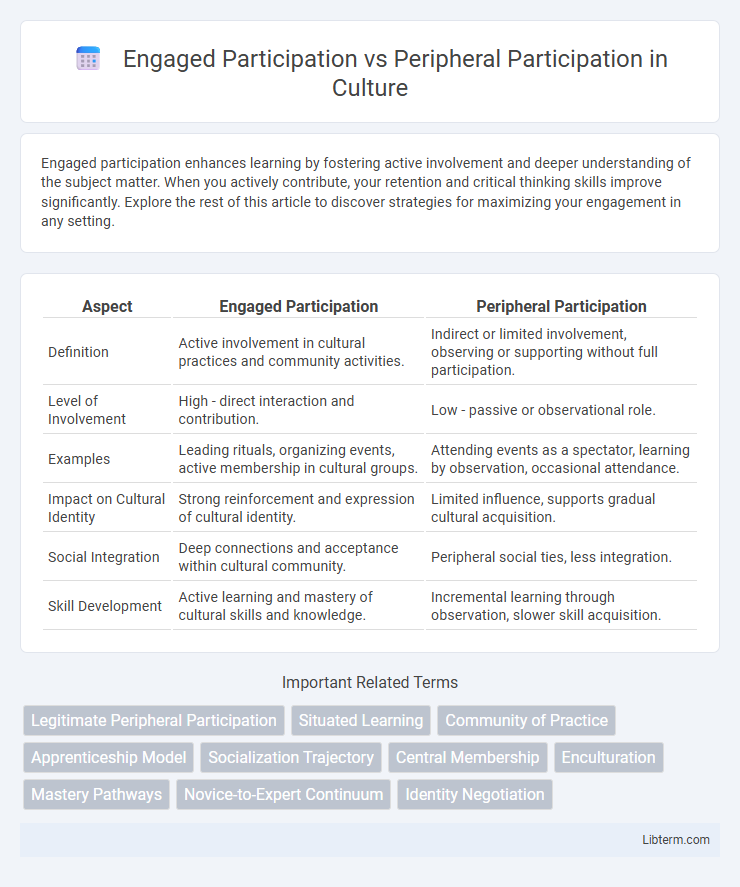Engaged participation enhances learning by fostering active involvement and deeper understanding of the subject matter. When you actively contribute, your retention and critical thinking skills improve significantly. Explore the rest of this article to discover strategies for maximizing your engagement in any setting.
Table of Comparison
| Aspect | Engaged Participation | Peripheral Participation |
|---|---|---|
| Definition | Active involvement in cultural practices and community activities. | Indirect or limited involvement, observing or supporting without full participation. |
| Level of Involvement | High - direct interaction and contribution. | Low - passive or observational role. |
| Examples | Leading rituals, organizing events, active membership in cultural groups. | Attending events as a spectator, learning by observation, occasional attendance. |
| Impact on Cultural Identity | Strong reinforcement and expression of cultural identity. | Limited influence, supports gradual cultural acquisition. |
| Social Integration | Deep connections and acceptance within cultural community. | Peripheral social ties, less integration. |
| Skill Development | Active learning and mastery of cultural skills and knowledge. | Incremental learning through observation, slower skill acquisition. |
Introduction to Participation Types
Engaged participation involves active involvement and direct contributions within a community or activity, fostering deeper learning and collaboration. Peripheral participation refers to observing or minimally engaging in a community, allowing newcomers to gradually acclimate and absorb knowledge without immediate full involvement. Understanding these participation types is essential for designing effective social learning environments and promoting sustained community engagement.
Defining Engaged Participation
Engaged participation involves active, deliberate involvement in activities or discussions where individuals contribute meaningfully and influence outcomes within a community or learning environment. This form of participation is characterized by intentional engagement, deep cognitive investment, and ownership of tasks that align with group objectives. It contrasts with peripheral participation, which entails observational or minimal engagement without significant impact on the collective process.
Understanding Peripheral Participation
Peripheral participation allows individuals to engage in a community of practice by observing and gradually contributing without full involvement, fostering learning through exposure and interaction. This mode of participation supports skill acquisition and social integration by providing access to community norms and practices while minimizing pressure or risk. Understanding peripheral participation reveals its critical role in enabling novices to transition toward full engagement organically within social and professional environments.
Key Differences Between Engaged and Peripheral Participation
Engaged participation involves active involvement, direct contribution, and continuous interaction within a community or activity, leading to deeper learning and stronger social bonds. Peripheral participation, by contrast, consists of observational involvement or limited engagement, allowing individuals to gradually acquire knowledge without full commitment or responsibility. Key differences include the level of engagement, frequency of interaction, and the depth of experience gained through participation.
Motivations for Engaged Participation
Motivations for engaged participation often include intrinsic interest, a strong sense of community belonging, and the desire to contribute meaningfully to group goals. Participants are typically driven by personal relevance and the opportunity for skill development, which fosters deeper commitment and active involvement. This contrasts with peripheral participation, where motivations are generally lower, focused on peripheral observation or limited engagement with fewer invested resources.
Factors Encouraging Peripheral Participation
Factors encouraging peripheral participation include low entry barriers, flexible time commitment, and minimal required expertise, allowing newcomers to gradually explore and learn without full immersion. Social support and accessible resources foster confidence and reduce intimidation, promoting sustained engagement at the margins. Peripheral participation serves as a crucial stepping stone toward deeper involvement in communities of practice.
Impact on Learning and Community Development
Engaged participation enhances learning outcomes by fostering active involvement, critical thinking, and deeper knowledge retention, which directly strengthens community development through collaboration and shared accountability. Peripheral participation allows learners to observe and gradually integrate into the community, promoting inclusivity and sustained engagement while providing a supportive environment for skill acquisition. Both participation types contribute uniquely to community dynamics, with engaged participation driving immediate impact and peripheral participation ensuring long-term growth and cohesion.
Strategies to Foster Engaged Participation
Engaged participation involves active, meaningful involvement in activities, while peripheral participation refers to more observational or marginal involvement. Strategies to foster engaged participation include creating inclusive environments that encourage dialogue, offering clear roles and responsibilities, and providing regular feedback to sustain motivation. Incorporating interactive tools and collaborative projects can also enhance commitment and deepen engagement in group settings.
Addressing Barriers to Participation
Engaged participation involves active involvement in decision-making processes, requiring accessibility and inclusivity to overcome barriers such as lack of information, time constraints, and social exclusion. Peripheral participation, characterized by indirect or passive involvement, often results from structural obstacles like limited access to resources or limited empowerment opportunities. Addressing these barriers requires tailored strategies including education, resource allocation, and fostering inclusive environments to transition individuals from peripheral to engaged roles in community or organizational settings.
Conclusion and Future Perspectives
Engaged participation fosters deeper learning and empowerment by actively involving individuals in decision-making processes, whereas peripheral participation offers observational insights but limited influence. Future perspectives emphasize integrating digital platforms and collaborative frameworks to bridge gaps between engaged and peripheral roles, enhancing inclusivity and real-time feedback. Leveraging emerging technologies can transform peripheral participants into active contributors, promoting more dynamic and equitable participation models.
Engaged Participation Infographic

 libterm.com
libterm.com